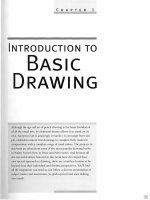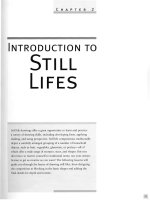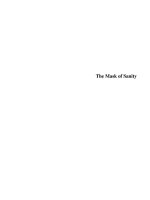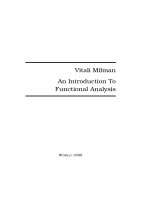11 the structure of language an introduction to grammatical analysis
Bạn đang xem bản rút gọn của tài liệu. Xem và tải ngay bản đầy đủ của tài liệu tại đây (2.35 MB, 422 trang )
This page intentionally left blank
The Structure of Language
An Introduction to Grammatical Analysis
Most of the time we communicate using language without considering
the complex activity we are undertaking, forming words and sentences in
a split second. This book introduces the analysis of language structure,
combining both description and theory within a single, practical text. It
begins by examining words and parts of words, and then looks at how words
work together to form sentences that communicate meaning. Sentence
patterns across languages are also studied, looking at the similarities and
the differences we find in how languages communicate meaning. The book
also discusses how context can affect how we structure our sentences: the
context of a particular language and its structures, the context of old and
new information for us and our addressee(s), and the context of our culture.
e m m a l . p a v e y is Assistant Professor of Linguistics at the Canada
Institute of Linguistics at Trinity Western University.
The Structure of
Language
An Introduction to
Grammatical Analysis
EMMA L. PAVEY
Trinity Western University, British Columbia
CAMBRIDGE UNIVERSITY PRESS
Cambridge, New York, Melbourne, Madrid, Cape Town, Singapore,
São Paulo, Delhi, Dubai, Tokyo
Cambridge University Press
The Edinburgh Building, Cambridge CB2 8RU, UK
Published in the United States of America by Cambridge University Press, New York
www.cambridge.org
Information on this title: www.cambridge.org/9780521517867
© Emma L. Pavey 2010
This publication is in copyright. Subject to statutory exception and to the
provision of relevant collective licensing agreements, no reproduction of any part
may take place without the written permission of Cambridge University Press.
First published in print format 2010
ISBN-13
978-0-511-77648-9
eBook (NetLibrary)
ISBN-13
978-0-521-51786-7
Hardback
ISBN-13
978-0-521-73665-7
Paperback
Cambridge University Press has no responsibility for the persistence or accuracy
of urls for external or third-party internet websites referred to in this publication,
and does not guarantee that any content on such websites is, or will remain,
accurate or appropriate.
For goodness’ sake
Contents
List of figures
List of tables
Acknowledgements
Notes for instructors and readers
List of abbreviations
1 Introduction
1
2
Language for communication
The structure of language – a preview
2 The structure of words
1
2
3
4
5
6
What is a word?
Parts of words
How to find morphemes
The function of added morphemes
Morphological processes
Clitics
Exercises
3 The structure of sentences
1
2
3
Introduction to syntactic structure
Operators
Head-marking constructions
Exercises
4 The structure of meaning
1
2
3
Predicate classes
Semantic representations and roles
Macroroles
Exercises
5 Integrating language structure
1
2
3
How semantic roles are syntactically marked
Grammatical relations
Valence-changing constructions
Exercises
page ix
xii
xiii
xiv
xv
1
2
4
8
8
9
12
19
25
36
39
46
46
61
79
83
93
93
107
118
126
137
137
141
155
170
vii
viii
Contents
6 The structure of phrases
1
2
3
4
Noun phrase syntactic structure
Noun phrase operators
Adpositional phrases
Adjuncts
Exercises
7 Complex structures
1
2
3
4
5
Complex construction levels and types
Complex constructions
Serial verb constructions
Syntactic and semantic relations between clauses
Relative clauses
Exercises
8 The structure of information
1
2
3
Information structure terms and concepts
The morpho-syntactic marking of information structure
Questions and commands
Exercises
9 Language structure in context
1
2
3
4
5
Language, cognition and communication
Typology
Language families
Language, culture and thought
Language change and language contact
Exercises
List of languages
Glossary
Notes
References
Index
180
180
187
198
206
209
219
219
227
236
245
247
257
271
271
277
289
299
310
310
311
319
320
329
334
337
350
370
383
398
Figures
3.1
3.2
3.3
3.4
3.5
3.6
3.7
3.8
3.9
3.10
3.11
3.12
3.13
3.14
4.1
4.2
4.3
4.4
4.5
4.6
4.7
4.8
5.1
5.2
5.3
5.4
5.5
5.6
6.1
6.2
Universal semantic elements
page 53
Universal syntactic elements
54
Syntactic elements of sentence 25
54
Constituent representation of sentence 25
56
Constituent representation of sentence 29 (b)
57
Constituent representations of non-verbal predicates
59
Constituent representation of specificational sentence 38 (b)
60
Syntactic core and periphery templates for English. Original
C Robert D. Van Valin, Jr 2005, reproduced with permission.
61
The scope of core and clausal negation
63
C
Syntactic representation. Original Robert D. Van Valin, Jr
76
2005, reproduced with permission.
Example syntactic representations for English sentences
76
Syntactic representation of 77 (a) and (b)
77
Constituent representation for head-marking sentence 82 (a)
81
Constituent representation of head-marking in Ch’orti’
81
Illustration of state predicate love
95
Illustration of activity predicate dance
96
Illustration of achievement predicate pop
97
Illustration of accomplishment predicates melt and recover
98
Illustration of semelfactive predicate clap
99
Picture of activity predicate semantic representations
111
Representation of adjunct
117
Representation of locative predicate
124
Nominative-accusative system
149
Ergative-absolutive system
150
Constituent representation of English active and passive
157
sentences
Constituent representation of Japanese active and passive
158
sentences
English noun incorporation construction
166
ASL sign for ‘fall’
167
The structure of noun phrases, adpositional phrases and
clauses
181
Constituent representation of a good book
181
ix
x
Figures
6.3 Constituent representation of the lid of the box
6.4 Constituent representation of deverbal noun. Original
C Cambridge University Press 1997, reproduced with
permission.
6.5 Constituent representation of NP with NPIP
6.6 Constituent representation of NPIP and NPFP. Original
C Robert D. Van Valin, Jr 2005, reproduced with permission.
6.7 Constituent representation of possessive constructions
6.8 Constituent representation of pronoun and proper noun
6.9 Overview of NP constituent and operator representation
6.10 Syntactic representation for noun phrases. Original C Robert
D. Van Valin, Jr 2005. Reproduced with permission.
6.11 Syntactic representation for English NP with nominal aspect
6.12 Syntactic representation of demonstratives in NPs
6.13 Position of adjunct adpositional phrase
6.14 Internal structure of predicative adpositional phrase. Original
C Robert D. Van Valin, Jr 2005. Reproduced with
permission.
6.15 Internal structure of non-predicative prepositional phrase.
Original C Robert D. Van Valin, Jr 2005. Reproduced with
permission.
6.16 Constituent representation of adjunct adpositional phrase
6.17 Constituent representation of argument-marking adpositional
phrase
6.18 Constituent representation of argument-adjunct adpositional
phrase
6.19 Constituent representation of clause-level adjunct
6.20 Constituent representation of core-level adjunct
6.21 Constituent representation of adjuncts at all three levels
7.1 Simple clause in English
7.2 Visual representation of complex constructions
7.3 Diagram representing coordination
7.4 Constituent representation of coordinate constructions
7.5 Diagram representing subordination
7.6 Diagram representing cosubordination
7.7 Constituent representation of cosubordinate constructions
7.8 Types of connection in complex constructions. Original
C Cambridge University Press 1997, reproduced with
permission.
7.9 Symmetry in complex constructions
7.10 Constituent representation of ad-clausal subordination
7.11 Syntactic representation of clausal cosubordination
7.12 Constituent representation of ad-core subordination
7.13 Constituent representation of core subordination
183
184
185
185
186
187
188
195
196
197
199
200
201
204
205
205
207
207
208
220
220
223
223
223
225
226
226
226
228
230
231
232
Figures
7.14 Syntactic representation of core coordination and core
cosubordination. Original C Cambridge University Press
1997, reproduced with permission.
7.15 Syntactic representation of nuclear subordination
7.16 Syntactic representation of nuclear coordination
7.17 Interclausal relations hierarchy. Original C Robert D. Van
Valin, Jr 2005, reproduced with permission.
7.18 English restrictive relative clause
7.19 Indonesian restrictive relative clause
7.20 Internally headed relative clause in Miskitu
7.21 English complex sentence for exercise A1
8.1 The cognitive status of referents. Original C Cambridge
University Press 1997, reproduced with permission.
8.2 Relationship between the expression of an NP and its
pragmatic status. Original C Robert D. Van Valin, Jr 2005,
reproduced with permission.
8.3 Constituent representation of the pre-core slot
8.4 Pre-core slot containing adjunct constituent
8.5 Constituent representation of the post-core slot
8.6 Constituent representation of left and right detached positions
8.7 Constituent representation of left detached position and
pre-core slot
8.8 Constituent representation of two left detached positions in
French
8.9 Constituent representation of it-cleft construction
8.10 Polar question in Austrian Sign Language
8.11 Syntactic representation of in-situ question in Tshangla
9.1 Scale of isolating and polysynthetic morphological types
9.2 Scale of agglutinative and fusional morphological types
9.3 Split intransitive grammatical relations system
9.4 Language family tree for Zome and Koireng
9.5 Representation of the Yimas view of time
9.6 Relative and absolute reference points
234
235
236
246
248
250
253
258
272
277
280
281
282
283
283
285
287
291
294
312
314
317
320
324
325
xi
Tables
2.1
2.2
2.3
2.4
2.5
2.6
2.7
2.8
2.9
2.10
2.11
2.12
2.13
4.1
4.2
4.3
4.4
4.5
4.6
4.7
4.8
4.9
4.10
4.11
5.1
6.1
6.2
6.3
7.1
8.1
8.2
xii
Kham data, version 1
Kham data, version 2
Kham data, version 3
Kham data, version 4
Kham data, version 5
Kham data, final version
Hungarian position class chart, version 1
Hungarian position class chart, final version
Yatˆe personal prefix paradigm
Halkomelem person particles with intransitive predicates
Derivational affix examples
Summary of differences between inflection and derivation
Summary of differences between affixes and clitics
Relationship between syntactic and semantic units
Properties of the five main predicate classes
Activities and active achievements
Properties of active achievements
Causative predicate classes
Morphological marking of states,
accomplishments/achievements and causatives
Semantic roles of state predicate arguments
Semantic roles of activity predicate arguments
Semantic roles and predicate classes
Hierarchy of semantic roles
Actor-Undergoer Hierarchy
Properties of valence-changing constructions
Pronoun types
Semantic roles of argument-adjunct adpositional phrases
Properties of adpositional phrases
Complex construction table for exercise A2
Terms associated with information structure
Constructional template for English content question
construction
page 14
14
15
15
16
16
17
18
20
21
24
24
38
94
100
101
101
102
107
110
112
116
118
120
169
187
202
205
258
274
298
Acknowledgements
I would like to thank all those who gave input and feedback during the process of
writing this book, and those who assisted with language data: in particular I would
like to thank Robert Van Valin, Jr, and also Bonnie Henson, Howard Jackson,
Madeleine van den Bovenkamp, Jamin Pelkey, Toshio Ohori and David Crozier.
I would also like to thank Tom Stobbe for his assistance in the compilation
process.
For keeping me sane during the book-writing process, I credit the time spent
with my friends at the A Rocha Centre in Surrey, BC.
Finally, my broad but sincere thanks also go to my ‘guinea pigs’, the students
at the Canada Institute of Linguistics at Trinity Western University (Langley, BC)
who helped me refine and improve this book, and who showed a keen aptitude
for finding typos. Remaining mistakes are of course mine.
xiii
Notes for instructors and readers
This book is intended to be read in order, from chapter 1 to chapter 9, as each
chapter builds on the content of previous chapters. It contains a large number of
exercises, over one hundred in total; chapters 2 to 8 contain two sets of exercises,
one set based on English and another set based on other languages. The degree of
difficulty of each exercise is indicated with asterisks: exercises with two asterisks
present more of a challenge than those with one asterisk. Several chapters include
text-based exercises both to provide variety and to guide the reader towards a
more realistic experience of linguistic fieldwork. There are also ‘mini-exercises’
in the text of each chapter, and additional exercises and resources are available
on the web via Cambridge University Press. In addition, this book offers an
extensive glossary (glossary items appear in the text in bold, small capitals at
their first occurrence) and a list of the 200+ languages referred to in this book;
the language list includes references where more information on each language
may be found.
A native or advanced level of English is assumed of the reader, but only basic
linguistic terminology is presupposed. As such, this book is ideally suited to
a second-level undergraduate class. It is also appropriate for an introductory
graduate-level class, particularly where the student is migrating from studying
formal approaches to syntax to a more functional approach (chapters 3 to 9 in
particular). Much of the syntactic framework used in this book comes from Role
and Reference Grammar Theory. For more comprehensive detail concerning this
theory, the reader is directed to consult Van Valin (2005) or Van Valin and LaPolla
(1997).
xiv
Abbreviations
1
2
3
i
ii
iii
a
aaj
abil
abl
abs
absol
acc
adj
adn
adv
advr
aff
afx
agr
agt
all
an
ant
antip
aor
appl
art
asp
asrt
assoc
assum
attr
atv
aug
1st person
2nd person
3rd person
class/type 1
class/type 2
class/type 3 (etc.)
actor
argument-adjunct adpositional phrase
abilitative case
ablative
absolutive
absolute
accusative
adjective
adnominal modifier
adverb/adverbial
adversative
affirmative
affix
agreement
agentive case
allative
animate
anterior
antipassive
aorist
applicative
article
aspect
assertive/assertative
associative
assumed evidential
attributive
active voice
augmented number
xv
xvi
Abbreviations
aux
av
bel
ben
bv
caus
cl
clf
clm
cm
cn
coll
com
comp
compl
conj
consec
cont
contr
cop
cst
cvb
dat
dcop
decl
def
deic
dem
der
des
det
detr
dex
dfut
dim
dir
dir.ev
dirc
disj
dist
dlmt
dm
d-s
dstr
auxiliary
agentive voice
belonging or association
benefactive
borrowed verb
causative
clitic
classifier / class marker
clause linkage marker
causee marker
common noun
collective
comitative
complementizer
completive
conjunct
consecutive marker
continuative aspect
contrastive focus particle
copula
contrast
converb
dative
deictic copula
declarative
definite
deictic
demonstrative
derivational affix
desiderative
determiner
detransitivizer
indexer
distant future
diminutive
directional
direct evidence evidential
direct case
disjunct
distal
delimitative
dependency marker
derived single argument
distributive
Abbreviations
du
dub
dur
emph
ep
erg
evid
excl
exist
ext
f
fin
foc
frust
fut
fv
gen
giv
h
hab
hort
hsy
id
if
imp
inan
incl
ind
indf
inf
infl
infr
ingr
ins
int
intr
ipfv
irr
iter
ix
lat
ldp
lim
lnk
dual
dubitative
durative
emphatic
emphatic pronoun
ergative
evidential
exclusive
existential
extension particle
feminine
finite verb
focus
frustrative
future
final vowel
genitive
given
human
habitual
hortative
hearsay evidential
identifiable
illocutionary force
imperative
inanimate
inclusive
indicative
indefinite
infinitive
inflectional affix
inferred evidential
ingressive
instrumental
interrogative
intransitive
imperfective
irrealis
iterative
use of the index finger to point
lative
left-detached position
limitative
linker
xvii
xviii
Abbreviations
loc
m
min
mkr
ml
mod
n
nasp
ndu
neg
neut
nf
nfut
nh
nm
nmlz
nom
np
npfp
npip
nprs
npst
nrl
nsg
nuc
num
nvis
obj
objv
obl
oblig
obs
onom
ov
p
pass
pat
pau
pbl
pc
pfv
pl
pn
pocs
locative
masculine
minimal number
marker
male
modality
neuter
nominal aspect
non-dual
negation
neutral
non-final marker
non-future tense
non-human
non-masculine
nominalizer
nominative
noun phrase
noun phrase final position
noun phrase initial position
non-present
non-past tense
non-relational prefix
non-singular
nucleus
number
non-visual evidential
object
objective
oblique
obligation
observational
onomatopoeia
objective voice
preposition
passive
patient
paucal
possibility
perfect converb
perfective
plural
proper noun
post-core slot
Abbreviations
pol
poss
post
pot
pp
prcs
prdr
pred
prep
pret
prf
pro
prob
proc
prog
prop
pros
prox
prp
prs
psa
pst
ptcl
ptcp
purp
q
qnt
qual
rc
rdp
rec
recp
red
ref
refl
reflposs
rel
rem
remf
rep
res
rl
rp
rpro
polite
possessive
posterior
potential mood
adpositional phrase
pre-core slot
predicator
predicate
preposition
preterite tense
perfect aspect
pronoun
probability
process
progressive
proper name
prospective aspect
proximal
present active participle
present tense
privileged syntactic argument
past tense
particle
participle
purposive
question marker/particle
quantification
qualitative
relative clause
right-detached position
recent past
reciprocal
reduplication
referential
reflexive
reflexive possessive
relative marker
remote past
remote future
reported evidential
resultative
realis
reference phrase
relative pronoun
xix
1
Introduction
KEY TOPICS
r
r
Language for communication
The structure of this book
Most of the time, if not all of the time, we communicate with each other using
language without considering the complex activity we are undertaking, forming
complex words and sentences in a split second. We know immediately when
someone uses language structures that are inappropriate or incorrect because we
have learned the rules that govern the language(s) we use. In this book, we will
look at the structures we use in more detail, in order to help us to understand the
structures we find in languages that may be arranged in ways quite different from
English.
There are many approaches to the study of language. Some linguists are more
interested in discovering the basic, innate structures that we all have in our brains,
regardless of which language(s) we speak. Linguists working in what is known
as the generative tradition seek to understand universal grammar, the
structures that human languages have in common and that we may be born with the
capacity to use. The generative approach focuses on the formal characteristics
of language structure, seeking to uncover the rules that ‘generate’ well-formed
sentences. Other linguists take a more functional approach, studying language
use in context; in other words, what actually comes out of our mouths rather than
what may be stored in our heads. Functional approaches seek to incorporate the
meaning and broader context of language in order to fully understand language
structure.
In this book I present a practical, functional approach to describing and explaining language structure. In chapter 2, I present a step-by-step approach to analysing
the structure of words: the study of morphology. Chapters 3 to 8 draw specifically on Role and Reference Grammar theory (RRG) to help us understand the
structure of sentences by looking at form (syntax), meaning (semantics) and
function (pragmatics) (Van Valin and LaPolla 1997, Van Valin 2005). As well as
being a functional theory interested in language as a means of communication,
RRG theory seeks to be typologically adequate, to present a level playing field
for the analysis of all languages. This book does not cover every aspect of RRG
theory; for that, the reader is directed to the references. Rather, this book is an
1
2
introduction
introduction to the analysis of language structure, and I will make use of aspects
of RRG theory as a useful tool for that purpose.
In order to study language you need to look both at the big picture and the
small component parts of language. To take an analogy, consider psychologists and neurosurgeons. Both are ‘head doctors’, examining the way the brain
works. However, while a neurosurgeon might cut you open and look at different
parts of your brain, a psychologist is more likely to examine your behaviour
and how you actually use your brain. Both are essential (as well as lots of
other types of ‘head doctors’) for a complete understanding of the brain, and
both do different things well to that end: however, the psychologist cannot help
you much with a tumour, and a neurosurgeon cannot cure you of compulsively
eating chocolate cake. In this book, I will ‘cut language up’ into component
parts in each chapter in order to ultimately have a better understanding of how
it functions as a whole, integrated thing in the minds, mouths and hands of
speakers.
In the next section I will introduce some general features of language, and then
move on to a description of the contents of the book.
1.
Language for communication
1.1
A symbolic gesture ⅢⅢⅢⅢⅢⅢⅢⅢⅢⅢⅢⅢⅢⅢⅢⅢⅢⅢⅢⅢⅢⅢⅢⅢⅢⅢⅢⅢⅢⅢⅢⅢⅢⅢⅢⅢⅢⅢⅢⅢⅢⅢⅢⅢⅢⅢⅢⅢⅢⅢⅢⅢⅢⅢⅢⅢⅢⅢⅢⅢⅢⅢⅢⅢⅢⅢⅢⅢⅢⅢⅢⅢⅢⅢⅢⅢⅢⅢⅢⅢⅢⅢⅢⅢⅢⅢⅢⅢⅢⅢⅢⅢⅢⅢⅢⅢⅢⅢⅢⅢⅢⅢⅢⅢⅢⅢⅢⅢⅢⅢⅢⅢⅢⅢⅢⅢⅢⅢⅢⅢⅢⅢⅢⅢⅢⅢⅢⅢⅢⅢⅢⅢⅢⅢⅢⅢⅢⅢⅢⅢⅢⅢⅢⅢⅢⅢⅢⅢⅢⅢⅢⅢⅢⅢⅢⅢⅢⅢⅢ
Onomatopoeia describes words that sound like their meaning, such
as buzz, click and meow. Onomatopoeia is one type of iconicity; something is
iconic in this sense if it resembles its meaning in some way. This: . . .
. . . is
an iconic sign because it resembles the thing it is representing. There is a direct
relationship between the form of the word and the thing it represents.
However, for the vast majority of words in any language the relationship is
arbitrary. The sound of a word bears no direct relationship to the meaning it
represents. Thus bird, oiseau, p´ajaro and ndege are arbitrary sequences of sounds
used to represent the idea of a bird (in English, French, Spanish and Swahili
respectively).
Our ability to deal with arbitrary symbols means we can use language as
an abstract system; we can talk about things that are not physically present
because we can associate the word with the referent even though there is only an
arbitrary connection between the form and the meaning. When we manipulate
such arbitrary symbols, it is more than a Pavlovian response (Deacon 1997: 68).
As an abstract system, we can also use language to talk about events in the past,
events within events (e.g. the man I saw last week is waving at me) or even events
in the imagination.
In terms of language structure, we also find some arbitrariness: some languages
put the verb last in a sentence, while others put it at the beginning. At the same
1. Language for communication
time, as we will see in chapters 7 to 9 in particular, we do find some iconicity
in the connection between certain sentence structures and the meanings they
express.
1.2
Do you know what I mean? ⅢⅢⅢⅢⅢⅢⅢⅢⅢⅢⅢⅢⅢⅢⅢⅢⅢⅢⅢⅢⅢⅢⅢⅢⅢⅢⅢⅢⅢⅢⅢⅢⅢⅢⅢⅢⅢⅢⅢⅢⅢⅢⅢⅢⅢⅢⅢⅢⅢⅢⅢⅢⅢⅢⅢⅢⅢⅢⅢⅢⅢⅢⅢⅢⅢⅢⅢⅢⅢⅢⅢⅢⅢⅢⅢⅢⅢⅢⅢⅢⅢⅢⅢⅢⅢⅢⅢⅢⅢⅢⅢⅢⅢⅢⅢⅢⅢⅢⅢⅢⅢⅢⅢⅢⅢⅢⅢⅢⅢⅢⅢⅢⅢⅢⅢⅢⅢⅢⅢⅢⅢⅢⅢⅢⅢⅢ
If you hear someone speak, or watch someone sign, in a language that
you do not know, what thoughts cross your mind? Can you tell where the words
begin and end? Do you consider it borderline miraculous that another person
could take any kind of meaning from that stream of sound or signs? The reality
is that practically every human being gleans a great deal of meaning from such
streams of communication in at least one language, and without a great deal of
conscious thought about the structure of the words and sentences they are using.
One of the most central factors that governs all language structures and communication is the tension between understandability and economy. Essentially,
this tension refers to the fact that we would like to get our message across as
clearly as possible with as little effort as possible.
In addition, language speakers are constantly creating new language forms,
primarily words but also structures. We can process and produce sentences we
have never heard or spoken before, because we know how to interpret the words
and structures we hear. We will examine in the next section how this is possible.
1.3
What it is and what it’s for ⅢⅢⅢⅢⅢⅢⅢⅢⅢⅢⅢⅢⅢⅢⅢⅢⅢⅢⅢⅢⅢⅢⅢⅢⅢⅢⅢⅢⅢⅢⅢⅢⅢⅢⅢⅢⅢⅢⅢⅢⅢⅢⅢⅢⅢⅢⅢⅢⅢⅢⅢⅢⅢⅢⅢⅢⅢⅢⅢⅢⅢⅢⅢⅢⅢⅢⅢⅢⅢⅢⅢⅢⅢⅢⅢⅢⅢⅢⅢⅢⅢⅢⅢⅢⅢⅢⅢⅢⅢⅢⅢⅢⅢⅢⅢⅢⅢⅢⅢⅢⅢⅢⅢⅢⅢⅢⅢⅢⅢⅢⅢⅢⅢⅢⅢⅢⅢⅢⅢⅢⅢⅢⅢⅢⅢⅢⅢⅢⅢ
When we study the component parts of a language, we are interested,
then, in two things: what the parts do and what they look like; in other words, the
function and the form. Think of a pencil. We can describe the basic formal
features of a pencil: it is a long, thin, pointed implement with a non-ink based
marker enclosed in wood. Its basic function, on the other hand, is as an instrument
for writing and drawing. So it is with language. The form of a word (or sign), for
example, is its phonological shape. Its function is what we do with the word; in
other words, how we use it to communicate.
We will see that it is important to be aware that we can use other things,
things with a different form, to perform the same function. Instead of a pencil, for
example, you could write with a pen or a piece of chalk or with paint. In addition,
you could use your pencil for other functions, such as pointing to something or
scratching your back. Once again, we can draw an analogy with language: in the
examples in (1), we see the same ‘form’ a tall student being used in two different
functions.
(1) (a)
(b)
A tall student stole my stapler.
Norman is a tall student.
In (1a), the sequence of words a tall student has the function of picking out a
particular referent; in other words, it is used to tell us something about the
3
4
introduction
identity of the one who stole the stapler. In (1b), on the other hand, a tall student
does not pick out a particular referent; instead, it gives us more descriptive
information about the referent picked out by Norman. Do not worry if this
distinction is not totally clear at this point; we will be returning to this difference
in chapter 3.
In the sentences in (2), on the other hand, we see different forms performing
the same function.
(2) (a)
(b)
(c)
That Norman stole my stapler saddens me.
Stealing saddens me.
Norman saddens me.
In every case, the function of the underlined element is to pick out the thing that
saddens me, even though the form of the underlined element is different: we have
a clause in (a), a verb in (b) and a noun in (c). We need to make sure we look not
only at the shape or form of an element but also at the function(s) it can have in
the sentence.
Section summary ⅢⅢⅢⅢⅢⅢⅢⅢⅢⅢⅢⅢⅢⅢⅢⅢⅢⅢⅢⅢⅢⅢⅢⅢⅢⅢⅢⅢⅢⅢⅢⅢⅢⅢⅢⅢⅢⅢⅢⅢⅢⅢⅢⅢⅢⅢⅢⅢⅢⅢⅢⅢⅢⅢⅢⅢⅢⅢⅢⅢⅢⅢⅢⅢⅢⅢⅢⅢⅢⅢⅢⅢⅢⅢⅢⅢⅢⅢⅢⅢⅢⅢⅢⅢⅢⅢⅢⅢⅢⅢⅢⅢⅢⅢⅢⅢⅢⅢⅢⅢⅢⅢⅢⅢⅢⅢⅢⅢⅢⅢⅢⅢⅢⅢⅢⅢⅢⅢⅢⅢⅢⅢⅢⅢⅢⅢⅢⅢⅢⅢⅢⅢⅢⅢⅢⅢⅢⅢⅢⅢⅢⅢⅢⅢⅢⅢⅢⅢⅢⅢⅢⅢⅢⅢⅢⅢⅢⅢⅢⅢⅢⅢⅢⅢⅢ
In this section you have learned:
r
r
the approach to analysing language structure adopted in this book,
to understand the arbitrary relationship between words and meaning,
to distinguish between form and function.
key terms: generative, universal grammar, formal, functional, typological adequacy, iconicity, understandability, economy, function,
form, referent
2
The structure of language – a preview
r
r
This book is designed to be read progressively, from chapter 1 through
to chapter 9. The concepts we will encounter are supported and illustrated by
data from over 225 signed and spoken languages. In addition, at the end of each
chapter there are two sets of exercises, one set based on English and one with
data from a wide variety of other languages. These are graded for their level
of difficulty: one asterisk ∗ indicates an easier exercise, while those with two
asterisks ∗∗ are more challenging.
When we seek to analyse a language, particularly a little-known language, we
do not always have access to lists of pre-selected data in nice, neat lists, as we see
in most of the exercises in this book. In fact, it is advisable, in seeking to elicit
‘natural’ data, to record various types of texts rather than isolated sentences. In
learning about language structures, it is best to begin by practising with neat sets
of data, but I have also included text-based exercises so that you can practise both
types of analysis.
2 The structure of language – a preview
2.1
The chapters ⅢⅢⅢⅢⅢⅢⅢⅢⅢⅢⅢⅢⅢⅢⅢⅢⅢⅢⅢⅢⅢⅢⅢⅢⅢⅢⅢⅢⅢⅢⅢⅢⅢⅢⅢⅢⅢⅢⅢⅢⅢⅢⅢⅢⅢⅢⅢⅢⅢⅢⅢⅢⅢⅢⅢⅢⅢⅢⅢⅢⅢⅢⅢⅢⅢⅢⅢⅢⅢⅢⅢⅢⅢⅢⅢⅢⅢⅢⅢⅢⅢⅢⅢⅢⅢⅢⅢⅢⅢⅢⅢⅢⅢⅢⅢⅢⅢⅢⅢⅢⅢⅢⅢⅢⅢⅢⅢⅢⅢⅢⅢⅢⅢⅢⅢⅢⅢⅢⅢⅢⅢⅢⅢⅢⅢⅢⅢⅢⅢⅢⅢⅢⅢⅢⅢⅢⅢⅢⅢⅢⅢⅢⅢⅢⅢⅢⅢⅢⅢⅢⅢⅢⅢⅢⅢⅢⅢⅢⅢⅢⅢⅢⅢⅢⅢⅢⅢⅢⅢⅢⅢⅢⅢⅢⅢⅢⅢⅢⅢⅢⅢⅢⅢ
In this book I begin with the smallest meaningful units of language
structure and move all the way through to examining complex sentences. In
terms of the study of linguistics as a whole, we begin our linguistic journey on
the outskirts of phonology (the study of sound patterns) and march right up to the
borders of discourse (the study of how whole texts are structured). In this section,
I will briefly introduce the topics of each chapter.
2.1.1
Chapter 2: the structure of words
In the next chapter, we will examine morphology, which is the study of parts
of words. Many words can be divided into pieces (morphemes), each of which
conveys a different part of the meaning of the whole. For example, if you were to
chop up the word underfunded you would probably end up with under-fund-ed,
and you would no doubt also be able to describe the meaning of each part of the
word as it contributes to the whole.
In this chapter we will learn how to ‘find’ various types of morphemes and
how to describe the ways in which they fit together to form words in different
languages.
2.1.2
Chapter 3: the structure of sentences
In chapter 3, we build on our knowledge of morphology to study syntax, which
is the study of sentence structure. We will see how the meaning of a sentence
and the way it is expressed are closely connected and that there are certain core
components that all languages have in common. We will also learn a way to
represent the syntactic structures that we find.
We will look at the basic elements of the sentence that tell us about what
happened and who was involved, and examine different ways that languages
express these parts of meaning. In addition, we will look at the modifying elements
that give more detail of various kinds, such as when it happened (tense) or indeed
whether it happened or not (negation).
2.1.3
Chapter 4: the structure of meaning
If syntactic structure is one half of a coin, the meaning of a sentence is the other.
This is the study of semantics, and we shall examine it further in chapter 4.
We will look at a way to describe the various types of events and situations
that sentences describe, and a method for representing those types that can be
used for any language. We will see that there is a close connection between the
type of event and the roles of the participants in that event.
2.1.4
Chapter 5: integrating language structure
The background that we establish in chapters 3 and 4 will enable us to examine
grammatical relations in chapter 5. We will look at how languages express
5









